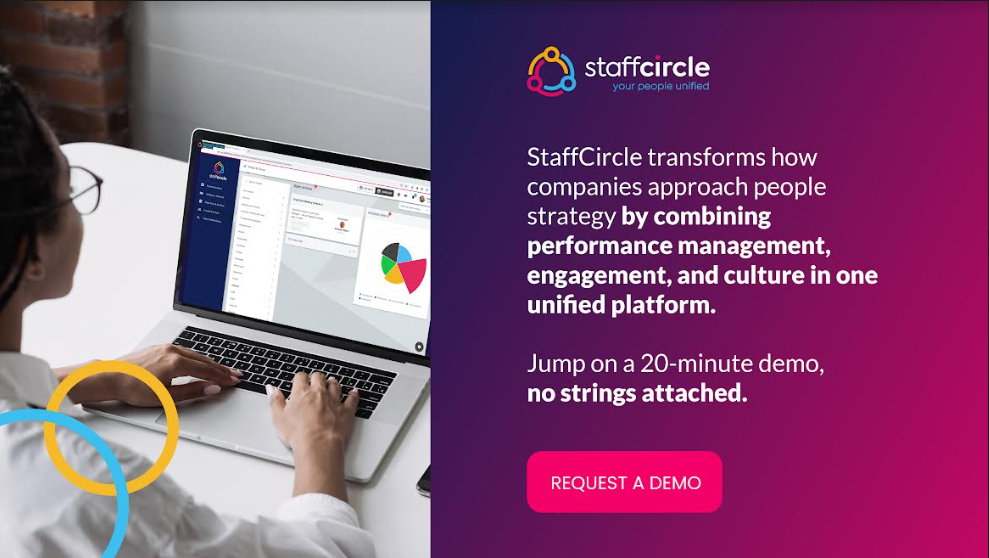Understanding the different types of performance management system which best fulfil your organisation’s needs
Performance Management is a holistic management discipline which needs to connect many relevant dots to involve development, enablement, and enhancement.
Pearl Zhu, author of Digital Maturity: Take a Journey of a Thousand Miles from Functioning to Delight
Different types of performance management systems offer businesses a comprehensive range of powerful tools. Different companies have different expectations regarding what they want to get out of such software. Understanding the various types of performance management systems is key to exploiting these tools to their full capacity.
These different types of performance management systems can be used to:
- Gain valuable insights into the organisational structure and distribution of human assets
- Bring individual professional ambitions in line with the company’s broad vision
- Create a process of continuous appraisals allowing for real-time course correction
- Understand – and develop – key competencies in teams and individuals
- Place physical and emotional well-being at the centre of the employee experience
1. Business Performance Management Systems for Insight Into Organisational Structure
Exploiting the latent potential of an organisation requires a complete understanding of its constituent components. A business performance management system gives leaders and executives a birds’ eye view of the company. Strengths and weaknesses can be easily spotted allowing for efficient allocation of the necessary resources.
Creating Clarity Surrounding Culture and Core Values
The report from Deloitte, Corporate culture: The second ingredient in a world-class ethics and compliance program, summarised the significance of a strong company culture as follows:
“Culture is one of the biggest determinants of how employees behave. Strong cultures have two common elements: there is a high level of agreement about what is valued, and a high level of intensity with regard to those values.”
After determining the values which matter the most to your organization, it’s important to articulate them loudly and clearly. Use performance management software branding to raise the visibility of any slogans which reflect these core values. Onboarding can then be brought in to make sure new hires understand the expected behaviours.
As the company continues to evolve, new announcements relating to changes in the company – or simply sharing success stories – can be shared through news feeds.
Understanding the Composition of the Organisation
Performance management software often features a comprehensive range of admin tools. These tools can reduce considerable time putting together paperwork, allowing leaders to:
- Store employee details, including sensitive contractor and company information, in a people database.
- Update job descriptions, payroll details and emergency contact information instantly.
- Develop departmental and organisational charts. These create instant clarity as to how a given individual’s role relates to the wider company.
- Ensure the right individuals are connected with one another.
Large companies seeking to streamline complex processes can dig deeply into their organisation’s structure. SME owners looking for the right type of performance management system for small business requirements can lay the workforce analytic foundations and set themselves up for growth.
Likewise, of the different types of performance management systems, it’s also a great fit for start-ups looking to start on the right foot.
2. Creating a Workforce That Excels With a Performance Management and Development System
A performance management and development system allows managers and team leaders to transform performance-related data into actionable development programs. By keeping performance and development interwoven, employees can grow as individuals in tandem with their role in the company.
Aligning Individual and Team Performance
In order for individuals to fully develop within their role, they need to be aligned to their team or department and the company as a whole. Performance management systems allow managers to set clear goals for employees which directly relate to the broader objectives of their team.
Whether you’re using objectives and key results (OKRs) or Key Performance Indicators (KPIs), these can be tracked in real-time to gain insights into alignment. Additional feedback mechanisms, which include peer-to-peer feedback, bring the necessary context regarding how an individual’s performance is developing.
Ongoing Development of Skills With Learning Tools
Information gathered from data analytics relating to goals and feedback from colleagues can help managers and team leaders drive development through training. Learning and development programs come in a wide variety of forms:
- Training programs featuring lectures, online courses, podcasts, and other easily consumed digital media.
- Long-term qualifications, such as degree programs relating directly to their role.
- Task and job rotations which give employees exposure to different roles within the company.
- Coaching and mentoring. Connect individuals within the organization who can share skills.
- Workshops and committees. Use performance management forums or set up channels in Microsoft Teams to allow for brainstorming sessions of innovative thinkers.

3. Using a Performance Management Appraisal System for Continuous Feedback and Employee Growth
Appreciate everything your associates do for the business. Nothing else can quite substitute for a few well-chosen, well-timed, sincere words of praise. They’re absolutely free and worth a fortune.
Sam Walton, founder of Walmart
One of the cornerstones of high achievement and happiness is the development of strengths. As employees continue to develop existing and new skills, HR leaders and managers can keep them on the right track with a performance management appraisal system.
Creating a Culture of Ongoing Feedback
Executive coach Ed Batista outlines the significance of building a feedback-rich culture in his article for the Harvard Business Review:
“To become more effective and fulfilled at work, people need a keen understanding of their impact on others and the extent to which they’re achieving their goals in their working relationships. Direct feedback is the most efficient way for them to gather this information and learn from it.”
Making ongoing feedback a part of your company’s culture can be accomplished through a combination of appraisal types.
Making the Most of Appraisals to Get the Best Performance From Employees
There are a variety of appraisal types business leaders and managers can use to create continuous conversations. Examples include:
Regular One2one Check-ins
A concern some business leaders have about regular feedback is that it will be time and energy-intensive. By employing the right types of performance management systems to set up templates and schedule one2one check-ins, these conversations become part of an automated process.
These regular sessions help spot any performance problems before they get out of hand. They also strengthen human relationships between managers, team leaders and employees. By building trust, managers can expect employees to be open to feedback and therefore work with increased morale.
Monthly and Quarterly Appraisals
Annual performance reviews pose a number of issues for HR administrators and managers. They are time-consuming, and produce a number of biases, for instance, recency bias which fails to take into account overall performance.
By contrast, quarterly or monthly reviews allow for frequent and constructive conversations which better reflect an employee’s current performance. As with regular check-ins, these appraisals can be fully automated so that little time and energy are required to plan and schedule.
By linking these appraisals to performance-related data reports, managers can bring the relevant evidence to the table so that employees are clear on their strengths and weaknesses.
Peer Feedback
Understanding the value employees bring to others’ work can be gained through peer feedback. Colleagues working closely together on the same teams possess unique insights into the challenges faced. Peer feedback gives them an opportunity to shine a light on accomplishments that management can easily overlook.
This lack of visibility is increasingly pronounced when employees are working from home. “As work becomes more interdependent and managers have less direct visibility into the day-to-day of their teams, high-quality peer input has become an essential part of effective performance feedback,” says Jessica Knight, research director at Gartner.
4. Creating Teams of a-players With a Competency Based Performance Management System
Organizations are made up of individuals who collectively possess a wide range of qualifications and skills. A mistake sometimes made when assessing individuals and teams is to focus on addressing skills gaps and other weaknesses. By using a competency-based performance management system, leaders can ensure that strengths are developed as well as weaknesses, boosting performance throughout the company.
Performance Management as Talent Management – Distribution of Skills
Each employee has their own unique skill stack reflecting their experiences and training. By creating a skills database through performance management software, business leaders and HR managers understand the overall distribution of available talent.
A skills database can include a broad range of hard and soft skills which can be drawn upon to further develop employees:
- Qualifications demonstrating expertise in a particular field.
- Completed online courses tied to job roles and responsibilities.
- Technical training to improve systems operations.
- Public speaking abilities to improve presentations.
Linking Performance to Promotions and Succession Planning
Leadership qualities can also be identified to help make informed decisions about new managerial roles and promotions. Employees who show great potential to become the leaders of the future can be identified and nurtured within their roles.
This makes succession planning far easier, as those team players who have a proven track record working effectively with their peers are already being developed for new roles. When current managers retire or leave the company, continuity of operations can be smoothly maintained as employees transition into leadership positions.
5. Improving the Workplace Experience With a Performance Management System for Employees
The restrictions imposed as a result of the COVID-19 pandemic radically changed the way employees work. As remote working morphs into hybrid work patterns, members of staff will divide their time between working from home and in the office space.
This creates new challenges for managers and HR professionals when it comes to the health and well-being of the company. How can managers best identify when individuals are struggling to maintain a healthy work-life balance? What protocols can be initiated to deliver logistical and other resource support when employee performance begins to slip?
These challenges can be overcome with the use of a performance management system for employees.
Understanding Employee Sentiment to Improve the Workplace
Regular one2one feedback sessions are among the best methods for managers to keep track of employee sentiment. However, some employees aren’t comfortable giving frank feedback either face to face or via video conference calls.
Business leaders can gain greater insight into the employee experience through anonymous feedback mechanisms. These include:
- Questionnaires and surveys. Digital surveys can be distributed throughout the workforce asking a range of questions relating to employee experience. What do employees enjoy about working for the company? What measures are ineffective or could be improved?
- Employee Net Promoter Scores (eNPS). These automated surveys give employees the opportunity to offer anonymous feedback and the effectiveness or otherwise of work satisfaction. Data analytics allows leaders to identify trends and work towards improving overall satisfaction.
- Culture feedback. Sometimes the company’s core culture no longer aligns with the day to day processes experienced by employees. Using culture feedback mechanisms allows business leaders to update their core philosophy as their business evolves.
Entering the Age of Hybrid Working – Promoting Physical and Mental Well-being
The combination of continuous feedback and employee sentiment analysis allows businesses to make the best decisions around improving well-being. This can be at the company-wide level, for instance by modifying the physical workplace or offering more flexible working.
On an individual level, companies can better understand the challenges of hybrid working. Promoting well-being to employees working from home can be achieved through a wellness action plan, which:
- Helps employees set up and stick to a routine.
- Assists with striking the right work-life balance.
- Keeps employees connected with other remote workers through multi-channel communications.
- Helps strengthen relationships between remote team members with virtual coffee breaks and “digital water cooler” tools.



